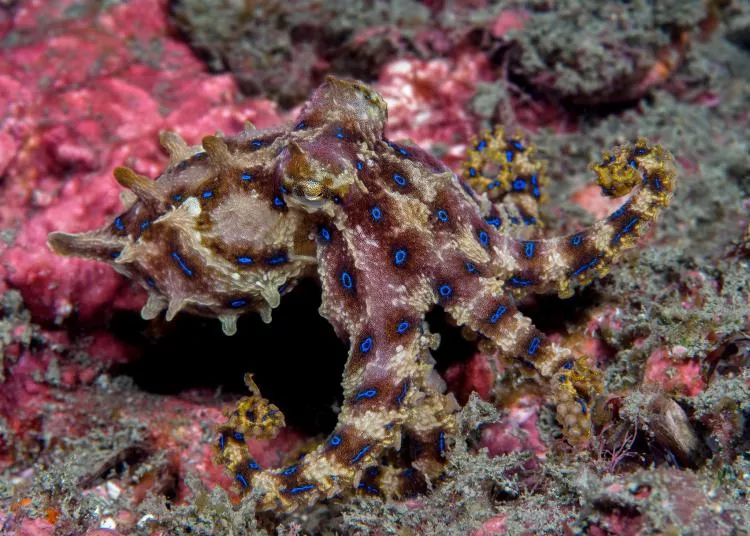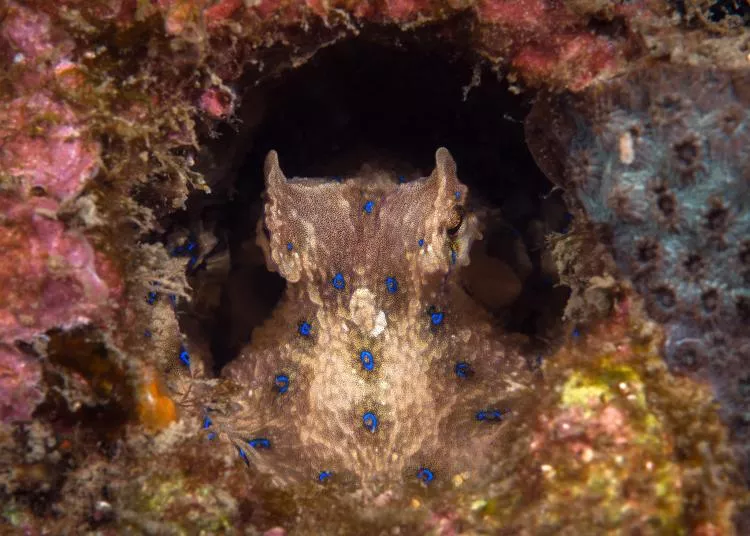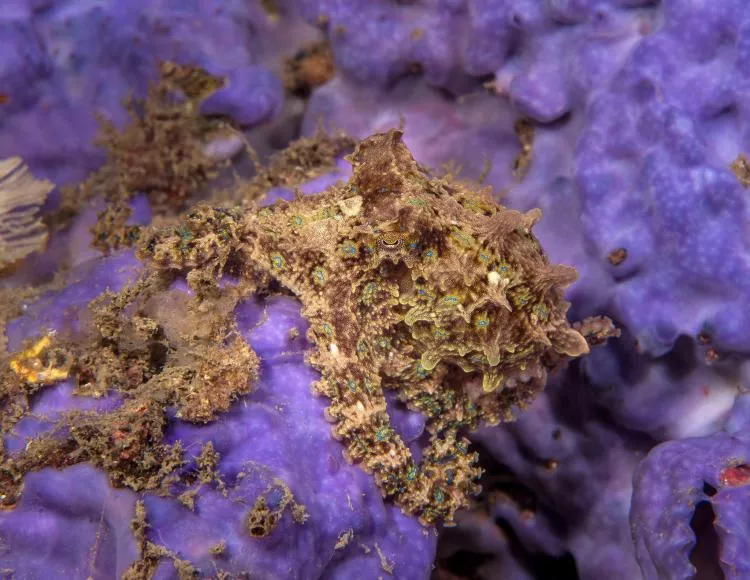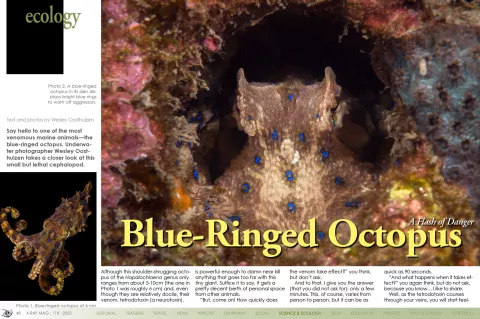Say hello to one of the most venomous marine animals—the blue-ringed octopus. Underwater photographer Wesley Oosthuizen takes a closer look at this small but lethal cephalopod.
Contributed by
Factfile
BLUE-RINGED OCTOPUS FACTS
• They are considered one of the most aggressive octopuses, but only a few cases, involving humans, have ever been reported.
• They have a relatively short lifespan of only two years. After mating, both the male and the female die.
• Despite its tiny size, the blue-ring octopus is extremely intelligent; it has a brain inside its head, but each arm (equipped with many suckers, which act like fingers) is also a brain that can think pretty much independently from the main one.
• They use their arms and suckers not only to think and act, but also to smell, taste and see.
• Like all octopuses, the blue-ring octopus has three hearts and blue blood.
• They are able to regenerate lost limbs.
• The blue-ring octopus is only visible if it feels agitated by a potential threat.
• Prefers shallow waters but can be found at up to 20m deep.
• Grows to a maximum length of 12 to 22cm, depending on the species.
• There are only four scientifically-named species (H. lunulata, H. maculosa, H. fasciata, H. nierstraszi). It is believed, however, that there are more than 10 different kinds.
• The average clutch of eggs is around 50, but they can have up to 100.
• Incubation of eggs takes around six months; during this time, the mother will not feed, nor will she leave the brood.
• They often secure their dens by piling up rocks to block intruders from entering.
Although this shoulder-shrugging octopus of the Hapalochlaena genus only ranges from about 5-10cm (the one in Photo 1 was roughly 6 cm) and, even though they are relatively docile, their venom, tetrodotoxin (a neurotoxin), is powerful enough to damn near kill anything that goes too far with this tiny giant. Suffice it to say, it gets a pretty decent berth of personal space from other animals.
“But, come on! How quickly does the venom take effect?” you think, but don’t ask.
And to that, I give you the answer (that you did not ask for): only a few minutes. This, of course, varies from person to person, but it can be as quick as 90 seconds.
“And what happens when it takes effect?” you again think, but do not ask, because you know… I like to share.
Well, as the tetrodotoxin courses through your veins, you will start feeling kind of funny. At this stage you are probably just thinking you are suffering from a bit of nitrogen narcosis, but very soon the toxins will paralyze your diaphragm. On the plus side though, your heart will keep beating until it runs out of oxygen, so don’t worry. It’s ok. At this point you are basically dead. Phew, it’s over.
However, on the small chance that you should be able to call emergency services, have someone do CPR on you until they arrive, and then get you put on a ventilator (until paralysis ends), you have about a 90 percent chance of survival! Easy-peasy.
Impact of the venom
“But, erm… just how long does the venom last?” you say at this point, with perhaps a little sweat on your brow and after gulping once or twice.
There is no real easy way to rip off this band-aid, so here it is: It takes about 15 hours until your muscles start working again and you are able to breathe without any assistance.
So, let’s say (hypothetically) that everything somehow fell into place, and you had everything you needed to survive a bite from one of these critters. Firstly, you lucky sod, you. Secondly, once the toxins have completely worn off, you can pretty much go home. Yip. Pretty much as if nothing happened. Aren’t you glad to be you?
But—those dang pesky “buts”—if you were not so lucky in getting enough oxygen to your brain, well then my friends, I am sad to say you will suffer permanent brain damage due to a lack of oxygen, and you probably will not be the person people knew you to be before, and in that case, I am so sorry to hear that.
“How much venom does a single bite contain?” ask the ones who are not hiding under their beds at this stage.
A single blue-ringed octopus has enough tetrodotoxin to end 10 fully grown men’s lives. Like jock-sized guys, not weedy dudes. So probably more than 10 averaged-sized guys.
How to spot an angry octopus
So, if you are still with us, then I am guessing (if you have not figured it out already) that you are wondering how to know if a blue-ring octopus is angry?
Example. This image (Photo 4). This is an angry blue-ring. It is certainly not happy with me and is not afraid to show it. Ordinarily, they are just a brown mucky-looking colour, but when a potential threat gets too close, they will flash these blue-rings as a warning to back right off or else!
Coming across something like a blue-ring octopus will make one realize that it is not the size of the creature, but the tetrodotoxin contained within its venom sack that counts. ■
Thanks go out to Yuan Yu (OM Digital Solutions), AOI, OrcaTorch, Atmos.
Sources:
biologydictionary.net
nhm.ac.uk
pbs.org
passportocean.com
treehugger.com

































